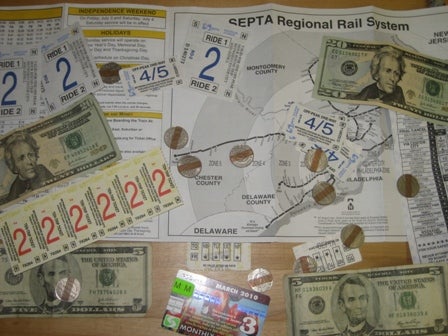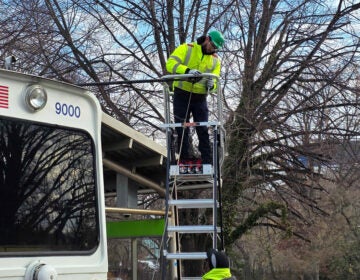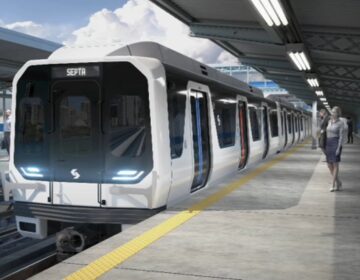SEPTA is still thinking about “smarter” way to charge

Although SEPTA’s long-term financial health is in jeopardy because of cuts to Act 44 state transportation subsidies, the authority is still trying to move ahead with a new smart card fare collection system.
John McGee, SEPTA’s chief officer of new payment technologies, told a meeting of SEPTA’s Citizen Advisory Committee that the authority remains in discussions with possible vendors and is looking at ways of building the system despite funding troubles.
At the same time, SEPTA appears to be leaning toward implementing a “toll-based” gating system on the regional rail network. If the authority goes ahead with this plan, riders won’t have to pay for inbound trips. Instead, they would pay double when leaving the three Center City stations, as well as at University City and Temple University. These stations would be gated, and riders would have to tap their fare instruments — be they credit cards, cell phones or transit cards — to get past the gates and onto the train platforms. Riders would then have to “check out” of the system in some way.
McGee said SEPTA is still figuring out how, but riders may have to either get their fare instruments scanned by train conductors or tap them against “validators,” machines placed in outlying stations that would ensure riders don’t travel farther than the destination they paid for.
McGee thinks this approach could solve some of the problems other transit agencies have encountered when trying to implement smart card systems on their commuter rail networks. (Though SEPTA isn’t expecting major challenges in rolling out smart cards for bus, subway and trolley users, no other older transit system has succeeded in switching to a smart card system for its railroad travelers.)
He said that focus groups of riders have told SEPTA that they’d be open to gating the Center City stations because they think gated areas provide more safety. McGee added that SEPTA likes the idea of gating stations because of the potential to cut start-up costs — SEPTA won’t have to buy ticket vending machines for all 150 regional rail stations and can focus investment on its core stations. Though SEPTA hasn’t formally decided to take this route, McGee did appear to discount a proof-of-payment system (http://en.wikipedia.org/wiki/Proof_of_Payment), whereby riders would purchase and validate their tickets before boarding and compliance would be randomly spot-checked by teams of SEPTA employees. A proof-of-payment system exists on the River Line (http://www.njtransit.com/ti/ti_servlet.srv?hdnPageAction=LightRailTicketsTo) and on commuter rail networks like Caltrain (http://www.caltrain.com/caltrain_tickets.html), in San Francisco. McGee said proof-of-payment systems lose too much revenue from fare evasion and thinks that a gated system could capture fares from the 94 percent of regional rail riders who make round trips using the system.
Outbound riders who board at stations outside of Center City would pay conductors on the train.
McGee was also able to detail tentative plans for the locations of fare gates that he said would disrupt existing traffic patterns as little as possible. Fare gates would be placed at the foot of the East stairs at 30th Street Station. The lesser-used West stairs would have gates at the top. Suburban Station would have a large area in the middle of the station that would provide access to train platforms, and Market East would have a large area with seating leading onto the tracks.
Transit riders, for their part, would see smaller changes. McGee and his team are looking at installing high gates at lesser-used entrances that are currently closed at night. They’re currently focusing on the 16th Street entrance to the City Hall station and the 31st Street entrance to the 30th Street El and trolley station.
SEPTA is also looking at gating the westbound 19th Street and 22nd Street subway-surface stations to allow for faster boarding.
Though Matt Mitchell of the Delaware Valley Association of Rail Passengers said that he appreciates that SEPTA is building an “open system” — riders will be able to use cell phones, credit cards or other devices to pay fares at the gates — he’s concerned by the gating proposal. He said gating system could increase fare-collection duties of on-board conductors and forestall SEPTA’s long-term goal of reducing regional rail crews to allow the authority to cut operating costs and reduce headways.
DVARP is also concerned with any plan that forces riders to “tag out” of the system, saying it adds a step for commuters who use passes. A gated system would force passholders to either use a validator or hand over their passes to conductors on every outbound trip.
Mitchell said he would like to see SEPTA implement a proof-of-payment system and install ticket vending machines at every station, adding that a proof-of-payment system provides more operational flexibility to SEPTA. At the same time, Mitchell acknowledged that “if they see the gates are practical, they’re going to do them” because of SEPTA management’s focus on eliminating the problem of uncollected tickets on trains.
Regardless of the type of system SEPTA decides on for regional rail, it hopes to get smart cards up and running as soon as possible after securing funding. McGee wants to begin installing smart card machinery at stations and on vehicles within 18 months of a notice to proceed with a specific vendor. The system would be fully in place and activated two years after a contract is announced.
Contact the reporter at campisi.anthony@gmail.com
WHYY is your source for fact-based, in-depth journalism and information. As a nonprofit organization, we rely on financial support from readers like you. Please give today.






